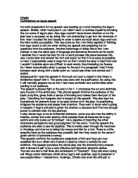The first literary device used is vile metaphors. Othello, who is the one who talks the most during this passage and uses very contemptible language, which is quite different to how people talk before this point. Othello’s harsh language serves to heighten the tension in the atmosphere. In addition, it demonstrates the decay of Othello’s character by the theme of jealousy and its power. The first place in the passage where Othello demonstrates this is near the beginning of the passage by saying, “Thou hast set me on the rack.” Othello’s metaphor between his torture and medieval torture shows not only the seriousness of the situation, but that his character would refer to such heinous instruments. Furthermore, Othello blatantly threatens Iago when he says, “Thou hadst been better have been born a dog/ Than answer my waked wrath!” This language would be unbecoming of a gentleman, during Shakespeare’s time, thus it demonstrates that Othello’s character has degraded completely because of the jealousy planted by Iago.
The second literary device used by Shakespeare is that of dramatic irony. However, it is in its most extreme form. This is shown in the passage when Othello tells Iago, “Villain, be sure thou prove my love a whore! / Be sure of it. Give me the ocular proof.” Here Othello is demanding Iago to prove that Desdemona unfaithful with visual evidence. The ocular proof is Othello’s entire basis for killing Desdemona, and the proof is coming from Iago, thus putting him in control of Othello’s fate. The handkerchief is the ocular proof that Iago produces in order prove Desdemona a cheater and a liar. This makes the passage a turning point in the play when Iago gains total control over Othello, while Othello doesn’t realize he’s being played, and will only after the plan is complete.
Finally, the third literary device used is setting. The passage is in the middle of Act 3, which would place it close or right on top of the climax, for a standard 5-part play. At the beginning of the scene, Cassio was talking to Desdemona about getting reinstated, and with Iago’s help Othello misinterprets it and thinks that Cassio is sneaking around behind his back. This shows that Iago has started to mold Othello into a jealous monster that will eventually lead to his downfall. This scene is the turning point because Iago has had the opportunity to have Othello see Cassio in Othello’s bedroom, talking to Othello’s wife, while whispering like a snake to him, that perhaps there’s something more between Desdemona and Cassio than meets the eye.
In conclusion, these three literary devices, metaphors, dramatic irony, and setting allow the scene to ascertain itself as being the turning point of the play. Othello has the seeds of jealousy planted within him now, and Iago is gulling both Othello and Roderigo. The effect on the audience is that they feel Othello’s emotions and can see the complete degradation of Othello’s character, allowing the audience to get in the mood for the downfall of Othello.








